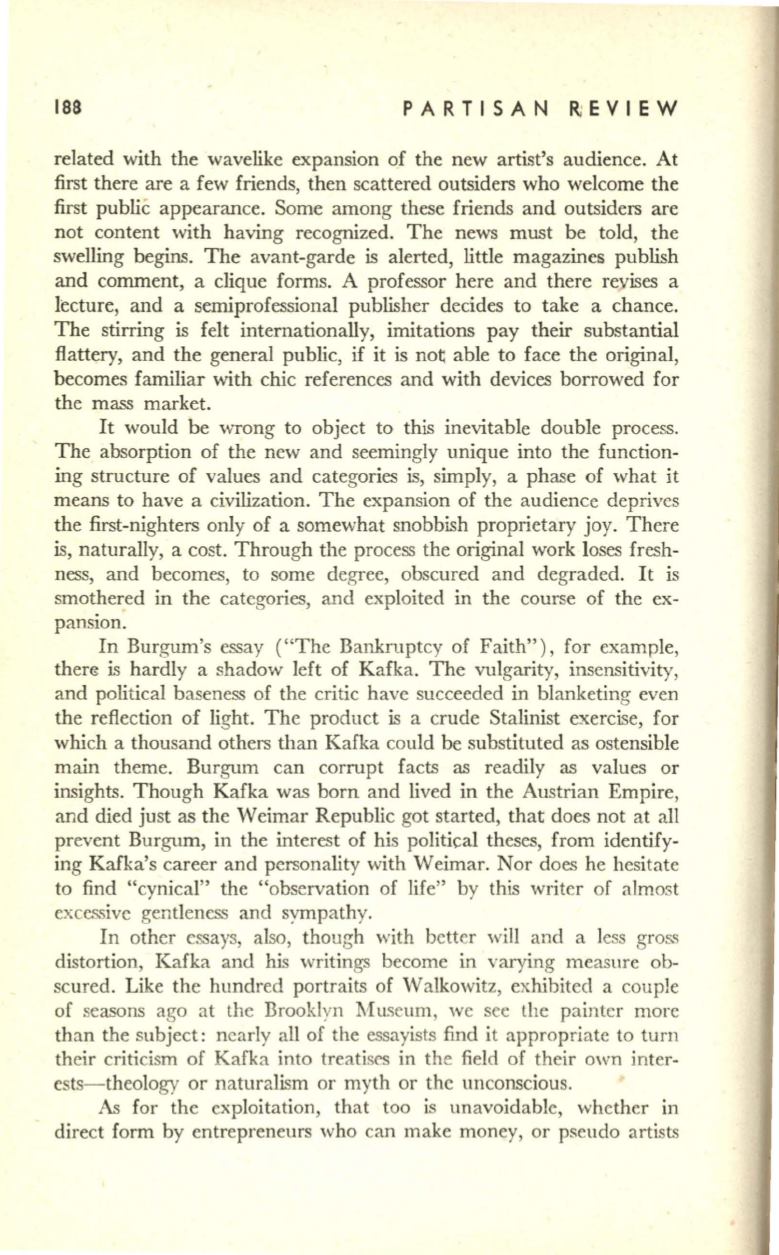
188
PARTISAN R;EVIEW
related with the wavelike expansion of the new artist's audience. At
first there are a few friends, then scattered outsiders who welcome the
first public appearance. Some among these friends and outsiders are
not content with having recognized. The news must be told, the
sweiiing begins. The avant-garde is alerted, little magazines publish
and comment, a clique forms. A professor here and there revises a
lecture, and a semiprofessional publisher decides to take a chance.
The stirring is felt internationally, imitations pay their substantial
flattery, and the general public, if it is not: able to face the original,
becomes familiar with chic references and with devices borrowed for
the mass market.
It would be wrong to object to this inevitable double process.
The absorption of the new and seemingly unique into the function–
ing structure of values and categories is, simply, a phase of what it
means to have a civilization. The expansion of the audience deprives
the first-nighters only of a somewhat snobbish proprietary joy. There
is, naturally, a cost. Through the process the original work loses fresh–
ness, and becomes, to some degree, obscured and degraded. It is
smothered in the categories, and exploited in the course of the ex–
pansion.
In Burgum's essay ("The Bankruptcy of Faith"), for example,
ther~
is hardly a shadow left of Kafka. The vulgarity, insensitivity,
and political baseness of the critic have succeeded in blanketing even
the reflection of light. The product is a crude Stalinist exercise, for
which a thousand others than Kafka could be substituted as ostensible
main theme. Burgum can corrupt facts as readily as values or
insights. Though Kafka was born and lived in the Austrian Empire,
and died just as the Weimar Republic got started, that does not at all
prevent Burgum, in the interest of his political theses, from identify–
ing Kafka's career and personality with Weimar. Nor does he hesitate
to find "cynical" the "observation of life" by this writer of almost
exce._c;sive gentleness and sympathy.
In other essays, also, though with better will and a less gross
distortion, Kafka and his writings become in varying measure ob–
scured. Like the hundred portraits of Walkowitz, exhibited a couple
of seasons ago at the Brooklyn Museum, we see the painter more
than the subject: nearly all of the essayistc; find it appropriate to turn
their criticism of Kafka into treatises in the field of their own inter–
ests- theology or naturalism or myth or the unconscious.
As
for the exploitation, that too is unavoidable, whether in
direct form by entrepreneurs who can make money, or pseudo artists


